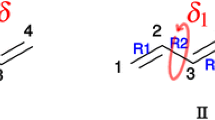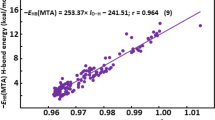Abstract
The characteristic aspects of dielectric constants of π-conjugated compounds are elucidated by a quantitative structure property relationship (QSPR) study. To develop a QSPR model, among 141 collected π-conjugated compounds, a subset of 116 compounds was used as the training set for the model building and the rest was used as the test set for the model validation. Statistical regression models using 396 molecular descriptors were generated based on the genetic function approximation algorithm. The predicted dielectric constants obtained by the best model are highly correlated with the experimental values (squared correlation coefficient R 2 of 0.93 and 0.97 for the training and test sets, respectively), while a previous prediction model for general organic molecules (Sild S, Karelson M (2002) J Chem Inf Comput Sci 42:360–367) is not valid for our collected π-conjugated organic compounds. It has been known that the dielectric constants of organic materials are largely influenced by orientational correlations of the constituent molecules. In general, hydrogen bonding is one of the most important intermolecular interactions affecting orientational correlation. In the case of π-conjugated compounds, however, π−π interaction could be another comparable interaction with the hydrogen bonding.


Similar content being viewed by others
References
Politzer P, Murray JS, Clark T (2010) Halogen bonding: an electrostatically-driven highly directional noncovalent interaction. Phys Chem Chem Phys 12:7748–7757
Murray JS, Riley KE, Politzer P, Clark T (2010) Directional weak intermolecular interaction: σ-Hole bonding. Aust J Chem 63:1598–1607
Goldman S, Joslin C (1993) Why hydrogen-bonded liquids tend to have high static dielectric constants. J Phys Chem 97:12349–12355
Raj CJ, Dinakaran S, Krishnan S, Milton B, Robert R, Das SJ (2008) Studies on optical, mechanical and transport properties of NLO active L-alanine formate single crystal grown by modified Sankaranarayanan–Ramasamy (SR) method. Opt Commun 281:2285–2290
Dhas SAMB, Natarajan S (2008) Growth and characterization of two new NLO materials from the amino acid family: L-Histidine nitrate and L-Cysteine tartrate monohydrate. Opt Commun 281:457–462
Lenin M, Ramasamy P (2008) Synthesis, growth and characterization of 3-nitroacetanilide—A new organic nonlinear optical crystal by Bridgman technique. J Cryst Growth 310:4451–4455
Zhao X, Wang M, Zhang B (2008) Structural and dielectric properties of conjugated polynitrile thin films deposited by plasma polymerization. Thin Solid Films 516:8272–8277
Dhara MG, Banerjee S (2010) Fluorinated high-performance polymers: Poly(arylene ether)s and aromatic polyimides containing trifluoromethyl groups. Prog Polym Sci 35:1022–1077
Katritzky AR, Maran U, Lobanov VS, Karelson M (2000) Structurally diverse quantitative structure-property relationship correlations of technologically relevant physical properties. J Chem Inf Comput Sci 40:1–18
Schweitzer RC, Morris JB (1999) The development of a quantitative structure property relationship (QSPR) for the prediction of dielectric constants using neural networks. Anal Chim Acta 384:285–303
Schweitzer RC, Morris JB (2000) Improved quantitative structure property relationships for the prediction of dielectric constants for a set of diverse compounds by Subsetting of the data set. J Chem Inf Comput Sci 40:1253–1261
Sild S, Karelson M (2002) A general QSPR treatment for dielectric constants of organic compounds. J Chem Inf Comput Sci 42:360–367
Liu J, Wilding WV, Giles NF, Rowley RL (2010) A quantitative structure property relation correlation of the dielectric constant for organic chemicals. J Chem Eng Data 55:41–45
Cocchi M, De Benedetti PG, Seeber R, Tassi L, Ulrici A (1999) Development of quantitative structure-property relationships using calculated descriptors for the prediction of the physicochemical properties (nD, ρ, bp, ε, η) of a series of organic solvents. J Chem Inf Comput Sci 39:1190–1203
Liu A, Wang X, Wang L, Wang H, Wang H (2007) Prediction of dielectric constants and glass transition temperatures of polymers by quantitative structure property relationships. Euro P J 43:989–995
Clipper Controls. Dielectric Constant Reference Guide. http://clippercontrols.com/pages/dielectric-constant-values. Accessed 18 Jan 2010
Lide DR (2000) CRC Handbook of Chemistry and Physics, 81st edn. CRC, Boca Raton
Delley B (2000) From molecules to solids with the DMol3 approach. J Chem Phys 113:7756–7764
Perdew JP, Burke K, Ernzerhof M (1996) Generalized gradient approximation made simple. Phys Rev Lett 77:3865–3868
Delley B (1990) An all-electron numerical method for solving the local density functional for polyatomic molecules. J Chem Phys 92:508–517
Hall LH, Kier LB (1995) Electrotopological State Indices for Atom Types: A Novel Combination of Electronic, Topological, and Valence State Information. J Chem Inf Comput Sci 35:1039–1045
Rogers D, Hopfinger AJ (1994) Application of genetic function approximation to quantitative structure−activity relationships and quantitative structure−property relationships. J Chem Inf Comput Sci 34:854–866
Stanton DT, Jurs PC (1990) Development and use of charged partial surface area structural descriptors in computer-assisted quantitative structure-property relationship studies. Anal Chem 62:2323–2329
Onsager L (1936) Electric moments of molecules in liquids. J Am Chem Soc 58:1486–1493
Zhao Y, Truhlar DG (2008) Density functionals with broad applicability in chemistry. Acc Chem Res 41:157–167
Acknowledgments
This study was supported by grant No. 10031803 from the Industrial Source Technology Development Programs funded by the Ministry of Knowledge Economy, Republic of Korea. We thank Accelrys Korea for support with the modeling software.
Author information
Authors and Affiliations
Corresponding author
Rights and permissions
About this article
Cite this article
Lee, A., Kim, D., Kim, KH. et al. Elucidation of specific aspects of dielectric constants of conjugated organic compounds: a QSPR approach. J Mol Model 18, 251–256 (2012). https://doi.org/10.1007/s00894-011-1067-7
Received:
Accepted:
Published:
Issue Date:
DOI: https://doi.org/10.1007/s00894-011-1067-7




